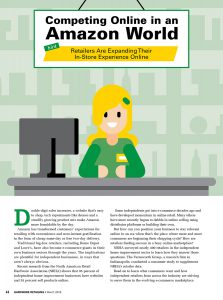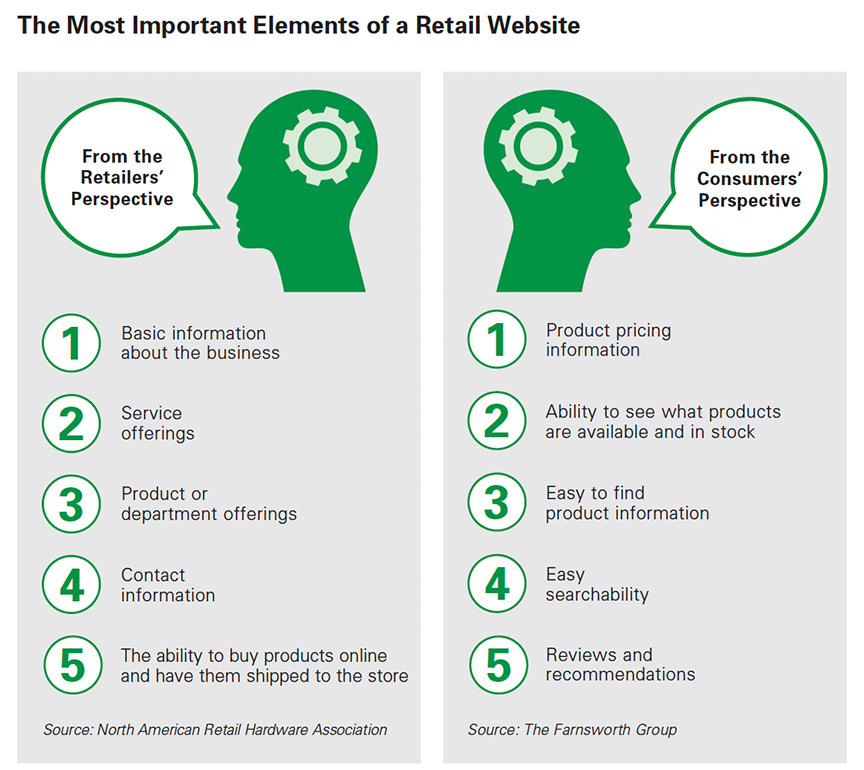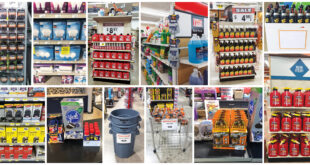Click the picture to download a PDF of this story.
By Kate Klein, kklein@nrha.org, and Todd Taber, ttaber@nrha.org
Retailers Are Expanding Their In-Store Experience Online
Double-digit sales increases, a website that’s easy to shop, tech experiments like drones and a steadily growing product mix make Amazon more formidable by the day.
Amazon has transformed customers’ expectations for retailing with convenience and near-instant gratification in the form of cheap same-day or free two-day delivery.
Traditional big-box retailers, including Home Depot and Lowe’s, have also become e-commerce giants in their own business sectors through the years. The implications are plentiful for independent businesses, in ways that aren’t always obvious.
Recent research from the North American Retail Hardware Association (NRHA) shows that 95 percent of independent home improvement businesses have websites and 55 percent sell products online.
Some independents got into e-commerce decades ago and have developed momentum in online retail. Many others have more recently begun to dabble in online selling using distributor platforms or building their own.
But how can you position your business to stay relevant online in an era when that’s the place where more and more consumers are beginning their shopping cycle? How are retailers finding success in a busy online marketplace?
NRHA surveyed nearly 400 retailers in the independent home improvement sector to learn how they answer those questions. The Farnsworth Group, a research firm in Indianapolis, conducted a consumer study to supplement NRHA’s retailer data.
Read on to learn what consumers want and how independent retailers from across the industry are striving to serve them in the evolving e-commerce marketplace.
‘Do It Differently’
Nearly 60 percent of the independents who participated in NRHA’s new research feel they cannot currently compete online against big retailers. About 57 percent, though, think they will be able to compete with what other home improvement industry websites offer within five years.
Many retailers are finding ways to use their websites, even without e-commerce, to serve their customers. However, they don’t expect to get as large as Amazon and the big boxes online or become the new standard for what e-commerce should look like.
“You can’t let it discourage you,” says Jessica Bettencourt, president of Klem’s in Spencer, Massachusetts. “The functionality of website like Amazon’s is very difficult or impossible for a small retailer to meet. However, there’s an opportunity to learn how you can do it differently or maybe even better.”
Independent retail operations, such as Klem’s, are finding that their online operations can complement what they’re already good at in stores, such as expert DIY advice and personalized customer service.
Bettencourt has been focusing on store renovations, and she thinks Klem’s website is the next area due for a major remodel.
The company’s current website offers customers the ability to check Klem’s inventory in real time and find out what events and promotions are happening in the store, but has plenty of room for improvement, Bettencourt says.
“I think there are a ton of things that we could do better,” she says. “Obviously, we can’t be Amazon. But where do we want to go and how do we get there? The primary focus of my e-store is really my current customers, for the most part. Selling products across the country isn’t realistic, but I think I can do a better job of servicing my communities online.”
Meeting Customer Expectations
While many retailers are excelling online by providing unique, specific content on their websites, delivering on customers’ e-commerce expectations can be difficult for several reasons.
Many retailers say the lack of employee time to commit to website maintenance and limited budgets to develop and implement e-commerce options on their websites are two driving factors slowing their entry into e-commerce.
Chief among retailers’ concerns is having the right people and enough time to make e-commerce a reality for their businesses. About 55 percent of survey respondents say they don’t have the manpower required to effectively maintain an e-commerce presence. And 53 percent of survey respondents say they don’t have enough time to devote to bringing e-commerce capabilities to their customers.
“Customers who walk in our store expect they’re going to get a better level of service in a family-owned place,” Bettencourt says. “It’s really challenging for us to bring that same service level to the web without having all the resources these other big businesses have.”
NRHA research indicates that many industry retailers have websites but aren’t satisfied with them. On a scale of one to 10, with 10 being “most satisfied,” nearly half of respondents rate their satisfaction at a five or lower.
Fortunately, they are listening to their customers and are willing to be creative, particularly with social media.
Many retailers are using a combination of social media platforms and websites to present online the personality, uniqueness and superior level of service that shoppers want from independent stores.
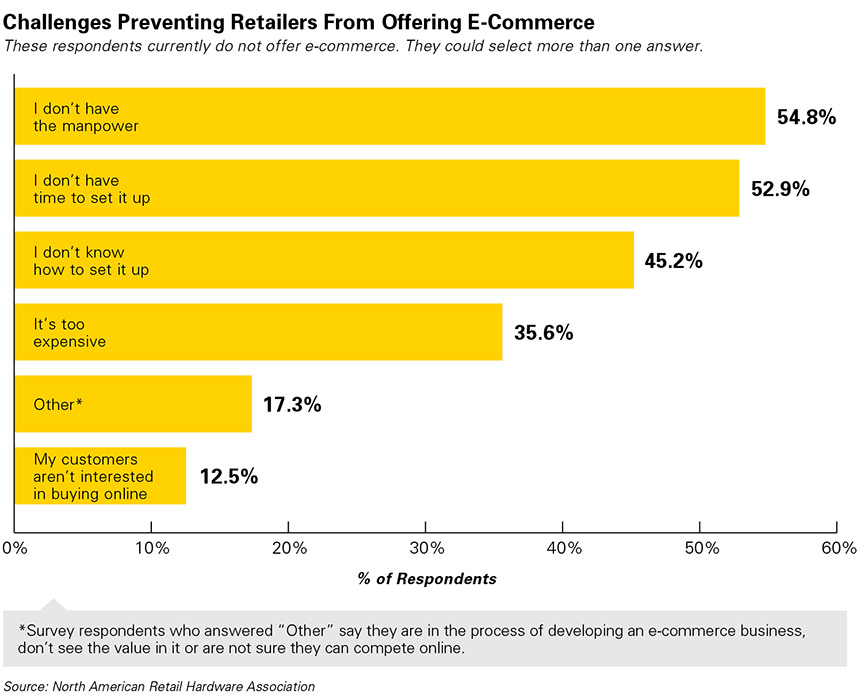
Some priorities retailers have for their websites, such as presenting store location information, are not business differentiators, but are basic customer expectations. Retailers can’t rely on those alone.
The research from The Farnsworth Group and NRHA shows that retailers are aware of what online customers say they value in a business’s website, such as product details and product availability in store. Plenty of retailers offer e-commerce functions, but even the retailers who don’t often know what customers expect from their websites.
There’s other good news, too—most customers agree with retailers that, when it comes to home improvement, online-only businesses cannot meet all of their needs.
Prioritizing Customer Needs
Bettencourt’s goal isn’t to strive valiantly for Klem’s to become progressively more like Amazon. Instead, she wants to make the website ahigh-quality service that meets customers’ changing expectations.
“We know that our online presence, especially our e-store, has a very long way to go,” she says. “I think that customers might give a little leeway when you’re a local business, but there’s only so much leeway when it’s 9 p.m. and they’re trying to figure out what to do first thing in the morning.”
Prioritizing the doable things customers are asking for is important, she says.
“Their time is really valuable,” she says. “The big thing going forward is, how do you save them time? It’s quite a percentage of our online orders that are picked up in store. It saves them a walk through the store.”
Klem’s likely won’t sell products worldwide, but can do better at keeping inventory up to date and marketed well on the website, Bettencourt says.
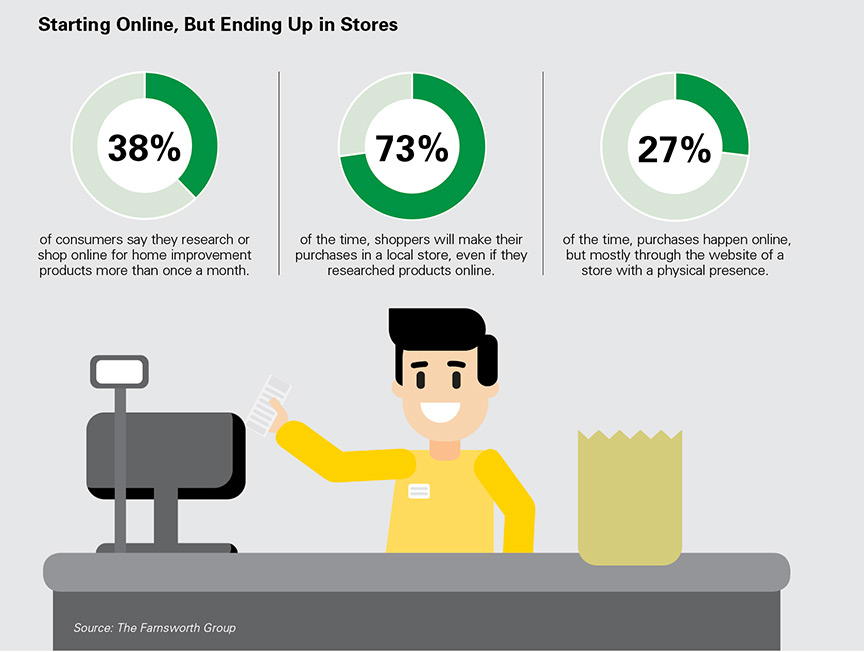
Online Strategies
Many retailers feel their best online weapons against encroaching e-commerce threats are advertising special events and reinforcing their brands to attract customers to their physical stores.
The main focus for Bill Jablonowski, owner of Jabo’s Ace Hardware in North Texas, and Andy Darnell with Howard Brothers in Georgia, is building their companies’ online identities authentically, even without their own proprietary e-commerce offerings.
Jabo’s has three locations and Howard Brothers operates five stores, and both retailers offer a portal to their wholesalers’ e-commerce platforms.
Howard Brothers’ website connects customers to what are essentially online catalogs of the company’s main product offerings: equipment sales, parts and service and repairs. A news section includes sales flyers, blogs about store events and industry happenings.
The Jabo’s Ace Hardware site features large graphics advertising in-store events, an upcoming community fundraiser and current job openings alongside links to the company’s social media accounts.
Having a web presence is an opportunity to solidify the Jabo’s Ace Hardware brand for customers, Jablonowski says.
“Our website is a necessary vehicle to get our message out there—who we are, why we’re different and what we’re doing to create excitement within our store,” he says. “At the end of the day, we’re hardware store owners, not internet gurus. We’re retail experts and we’ve focused our lives on how we can make retail work for us.”
Looking at Sales
On average, retailers who participated in NRHA’s research say digital sales account for 7 percent of their operations’ overall sales. More than 80 percent of the retailers believe that figure will grow throughout 2018. About 70 percent believe their investment in e-commerce has been worth the sales they’ve gotten from it.
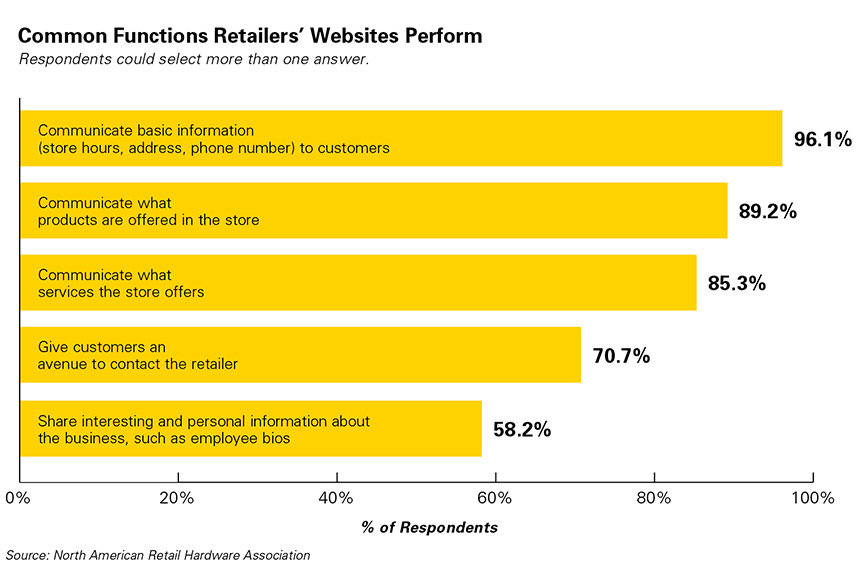
At Jabo’s Ace Hardware, online orders through the company’s wholesaler e-commerce portal are increasing each year, Jablonowski says. Jabo’s recently made its site mobile friendly to best present information to customers.
“We knew it was important to have a website out there that works on a variety of platforms,” Jablonowski says. His focus, though, is on getting as much foot traffic to his three stores as possible.
Darnell, who is director of marketing and communications for Howard Brothers, built his company’s website himself. Howard Brothers is still researching how to best compete online.
“We still haven’t figured out an e-commerce solution to the level that I think we should have,” Darnell says.
While his store does link to his wholesaler’s e-commerce portal, their online inventory might not accurately reflect what’s currently available at a Howard Brothers location, he says.
A Drive Toward Digital
Whether their e-commerce stores are robust or not, many retailers are learning that creating a multiplatform retail presence boosts business. They are leaning on social media strategies, engaging content and in-store events to differentiate their operations from the big boxes.
For Darnell and Howard Brothers, that means increasingly driving the company’s marketing budget toward digital advertising. Radio spots are the company’s biggest advertising expenditure, but Howard Brothers will be slowly paring down its money spent on radio ads to beef up online marketing initiatives, like running targeted Google AdWords campaigns, Darnell says.
Developing a Unique Online Identity
More than 60 percent of the retailers NRHA surveyed do not currently have a budget for online marketing and development, but 85 percent of respondents maintain a social media presence to stay top of mind with customers. Retailers say sharing photos and information and spreading the word about upcoming events are the most common ways they use social media.
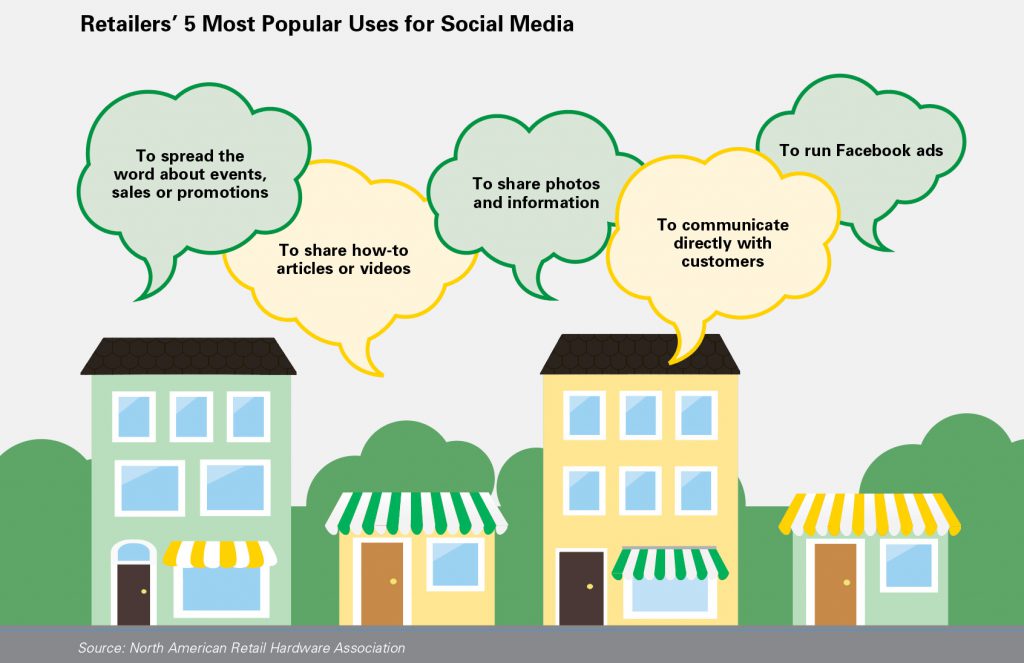
About 65 percent of retailers use social media to draw traffic to their websites, while also promoting their brick-and-mortar operations. Klem’s has more than 15,000 Facebook followers who engage with the business by participating in online contests, viewing photos and asking questions.
Howard Brothers regularly posts videos to its social media accounts, often of employees demonstrating new products or promoting in-store events. Videos build the company’s brand and help customers connect with Howard Brothers in a meaningful way, Darnell says.
“Our videos do really well,” he says. “If somebody finds a product video and they see one of our salespeople online, they know they can come in and talk to that person directly.”
The Nuts and Bolts of Order Fulfillment
For the NRHA survey respondents who offer some level of e-commerce, customers buying online and having their orders shipped to stores is the most common method of order fulfillment. Of the retailers who offer e-commerce, nearly 80 percent say they use this fulfillment option.
For Howard Brothers, competing against Amazon and other online retailers sometimes means using the competitors to their own advantage.
Howard Brothers sells new products on Amazon using a seller’s profile the business created roughly a decade ago. The company also sells used equipment parts on eBay. Howard Brothers then ships products directly to customers who order on Amazon or eBay.
Even without direct e-commerce capability on its website, Jabo’s Ace Hardware is still incorporating technology into its operations.
Jablonowski says that soon, his website will include a feature that allows customers to send questions directly to staff members via text message, initiating a one-to-one dialogue instantly with prospective customers.
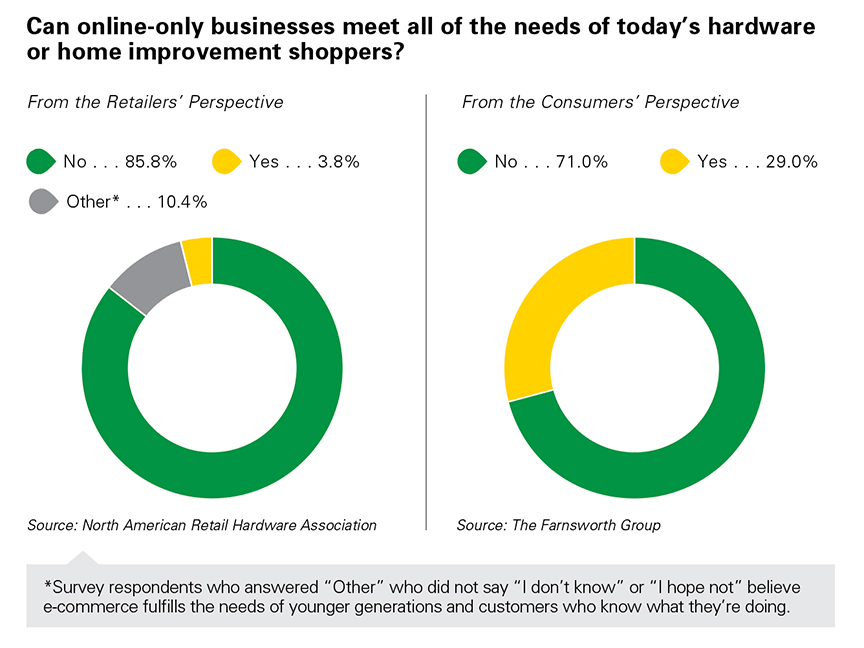
More than half of NRHA’s survey respondents feel that within five years they will have a website allowing them to compete directly online with big-box retailers. What that may mean varies by business.
Jabo’s Ace Hardware is ready to follow and meet customers wherever and however they’re shopping, Jablonowski says.
And Howard Brothers’ future online strategy will continue to rely heavily on generating unique content that establishes the business’s commitment to the communities it serves.
“The better we can look online from a reputation standpoint, the better,” Darnell says. “When someone is comparing us against a local competitor, we’ll always have the edge. They’ll go to whoever they feel most comfortable with, and our goal is to make us their top choice.”
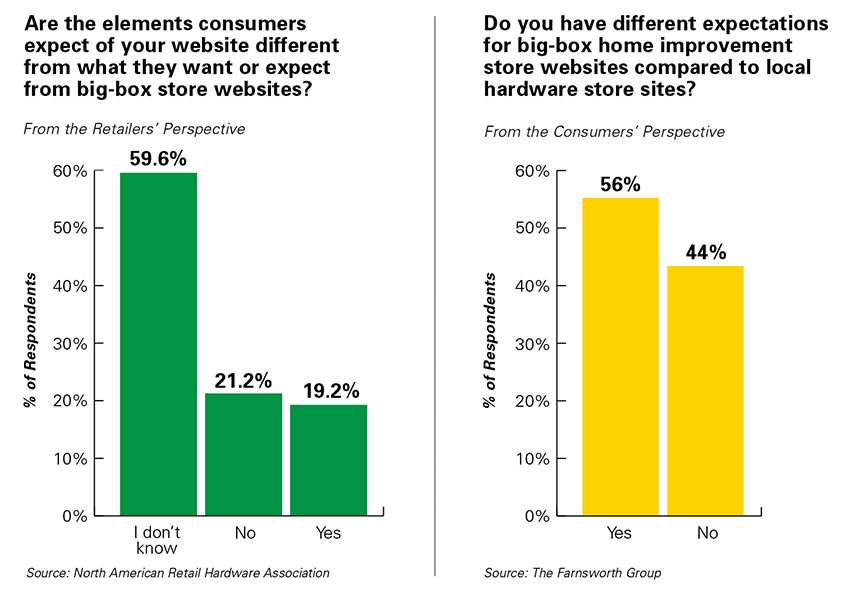
A Physical Advantage
Jablonowski believes brick-and-mortar stores will always have a competitive advantage over e-retailers.
Survey participants echo that sentiment nearly across the board, saying their businesses will remain relevant because customers, especially in the home improvement industry, still want in-store experiences.
Plus, if customers have a problem, such as a broken toilet, Amazon won’t coach them through fixing the issue, survey respondents say.
The folks at the locally owned home improvement store demonstrate products, explain the differences between similar items and make sure the customers know what to do when they get home to tackle a project.
“Being able to hold a product is important,” Jablonowski says. “Nothing replaces the ability to see and touch a product in person.”
 Hardware Retailing The Industry's Source for Insights and Information
Hardware Retailing The Industry's Source for Insights and Information




